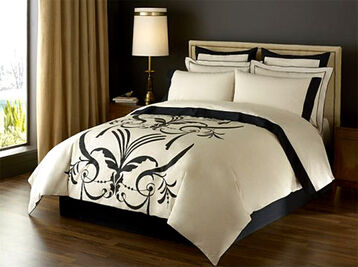
Choosing your bedding can be an even more important choice than the type of bed frame you choose, just because of the difference it makes in overall comfort. Make sure to take quality, feel, material, and style into consideration when you're making a purchase. You want everything to be comfortable and luxurious. Your bedroom is your oasis, and it should feel that way.
Make sure you choose the right size. If you've found the perfect sheet set, but they don't have it in the size needed for your bed, it can be tempting to buy a size larger. While you can pin and tuck the bedding, it'll never have that smooth look that it should, so it's usually not worth the investment.
Some primary fixtures of bedding sets include:
Bed Pillows and Shams[]
Choosing a good bed pillow can make or break your night's sleep. The best way to pick a good pillow is to try out several different styles, and then stick with what you know. Fill materials, support, cover material, and size are all important considerations. There are virtually endless combinations, and each person is different, so make sure you test out whether down, goose feather, or memory foam works best for you!
Shams are usually a stylistic choice, and should complement the rest of your bedding. Make sure your shams actually fit with the pillows that you've purchased! Trying to cram a pillow into a case, or finding out you've chosen a case that's far too large for your pillow is never a good look.
Bedskirts[]
Also called a dust ruffle, bedskirts help hide your mattresses box spring, and can help add another touch of flair and style to your bedding set. While most bedskirts are sold according to standard mattress sizes, you can always measure your boxspring's size in order to play it safe. Bedskirts today come in a variety of styles, from simple and casual, to more tailored and fitted options.
Bed Cover[]
A good bed cover can make all the difference in the look and feel of your bedroom. Not only is it the main piece of visible bedding, but it's also what's going to help keep you warm at night. There are several main options for bed covers, but most people tend to go with one or a combination of the following:
Comforter: Most quality comforters and duvets are rated based on a tog rating and filling. This is a measurement of its weight, softness, and warmth. The higher the tog rating, the warmer the comforter will be. Comforters are usually filled with a natural or synthetic material. Natural fillings (such as down), are usually much better at trapping heat than synthetic materials.
Duvet Covers: Essentially a pillowcase for your comforter, duvet covers come in a variety of fabric options, and are usually attached at the end with ties, buttons, or velcro. Make sure you choose a fabric that's easy to wash!
Quilts: A quilt can complement or replace a comforter or duvet. A quilt won't be as fluffy and full as a duvet, but it does make a significant difference in overall warmth.
Sheets[]
Most sheet sets include a fitted sheet, a flat sheet, and two pillowcases. Other than making sure you choose the right size, the most important thing to consider is material. Even if you've settled on cotton, you have tons of options to choose from, including Egyptian, Pima, Supima, Organic, Synthetic, and numerous blends. Thread count is also important. This counts the number of threads per square inch of fabric (both horizontal and vertical). If you're looking for a soft and durable sheet, a higher thread count (at least above 200) is better. There are also weave styles to choose from, including sateen, pinpoint, percale, and twill. All of these materials have different effects and overall textures. Make sure to actually touch the sheets to see how they feel, but also research different weaves and materials to see which is best for guest bedrooms, children, or daily use. Some weaves breathe and clean better than others.